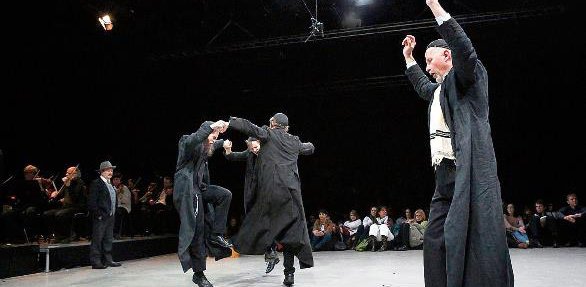The opera entitled The Red Heifer was premiered last autumn at the Millenáris with significant success among audiences and to both Hungarian as well as international acclaim.
Audiences can now watch it on 23 and 24 June before the Budapest Festival Orchestra and its large acting crew play it in Berlin at the end of the month. The piece will be performed on stage some time later in New York too.
The conductor, orchestra leader and composer, who is fairly sensitive to social problems and political issues, has touched upon an extremely delicate topic by bringing up the Tiszaeszlár show trial. Admittedly he does not put the trial itself in the centre of attention, but instead the Jewish adolescent boy betraying his family, and gives an account of and displays the story from his perspective.
– Playing a role in society is not an issue this time. I obviously believe that the shameful Tiszaeszlár show trial expresses everything that has kept destroying and dividing this country for over a century, but there is no point in talking about it too much as it is such an obviously evil act – says Iván Fischer.
When Miklós Erdély wrote and directed his film entitled Version in 1981, which dealt with the same topic, he and Iván Fischer were jointly planning an opera. Yet the story ultimately turned out to be different, though still based on Gyula Krúdy’s novel entitled “A tiszaeszlári Solymosi Eszter “ (Eszter Solymosi from Tiszaeszlár).
– I believe Móric Scharf was not enchanted by Eszter Solymosi, who was of his age, as shown by Erdély’s “version”, he was driven by the Jewish assimilation desire when he bore false witness against his own father.
THE MUSIC BECAME AN ECLECTIC MIX BASED ON SEVERAL ASPECTS.
This is still an extremely powerful desire in Hungarian Jews, sensed even today. A Jew does not understand why the Christian majority sets Jews apart from Hungarians. Lipót Lőw, the legendary Hungarian rabbi, and his followers joined Kossuth’s army. I still have a photograph of my great-grandfather wearing a Hungarian-style “atilla” (specially ornamented traditional Hungarian suit). And we know of turning Jews into Hungarians, Jews converting to Christianity, Jews in Transylvania joyfully hailing the reannexation, and families surviving the Holocaust where they kept their Jewish origins a secret from their children.
At one of the pivotal points of the music – which builds abundantly on folk music traditions – this is exactly what we see on Móric as he stumbles around and among young people happily folk dancing, i.e. his eager desire to belong to their motley, vivid and attractive group, and then there is the very solemn Jewish dance scene sort of counterbalancing this happiness.
– The music became an eclectic mix based on several aspects. Miklós Erdély and I also planned to put folk music and hasidic tunes “side by side”. I continued this by making the boy’s memories churning in his mind remind us of the era’s music. And once different musical styles coexist, they must also be ageless and deal with the future as the story itself does. I therefore also included some rap and blues elements to make it truly eclectic...
The concert brochure for the performance – and, as I believe, the future one for the guest performance in Germany too – not only gives a very detailed account of the Tiszaeszlár show trial and its preliminaries but also of Móric Scharf’s subsequent “confession”.
– I am an optimist so I happily read the interview with Móric Scharf thirty years later in which he reveals that he was forced and taken advantage of, but then he regretted what he had done and returned to Jewish religious life.
There is a long “silent scene”, which in fact is not silent at all as the orchestra keeps playing while the drum imitates the clatter of a train engine, but we still hear the silence in it. When the father is set free after a year – having been proven innocent – he and his son travel to Budapest. They sit in the compartment in silence. A risky move in an opera. So the performance directed by Tamás Ascher must answer what is happening during this time.
– Everyone must find out for themselves. A few days earlier the boy had stayed with the family of the Nyíregyháza constable, a Catholic teacher gave lessons to him, and now he is sitting in the train opposite his father wearing a caftan and sidelocks (payos)... Móric claims his father never spoke about the trial with him. I guess he wanted to get his son back. This is a one-hour opera. Will it have a counterpart, another single-act opera? – the question is put to the composer Iván Fischer who replies as follows: Yes. If I have the time, I will compose its counterpart. I already have an idea as to how the new opera should link in to The Red Heifer, but I won’t tell you now.


